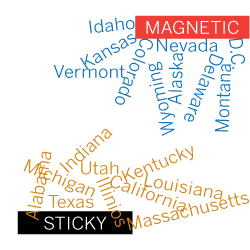Is Your Church Sticky and Magnetic?
Sam Rainer

After digging into Census data, the Pew Research Center has uncovered trends about each state and uniquely packaged them in a memorable format. They have created a typology that groups states as “sticky,” “magnetic,” both, or neither.
They define each term: “Magnet” states are those in which a high share of the adults who live there now moved there from some other state. “Sticky” states are those in which a high share of the adults who were born there live there now.
It’s a great way to look at population changes and migration between states. Each state can be grouped into one of five categories.
High Sticky/High Magnet. Attract a lot of people and retain most of the population born there. My current state of residence, Florida, is an example.
Low Sticky/Low Magnet. Do not attract a lot of people and lose much of the population born there. Maine is an example.
High Sticky/Low Magnet. These states retain many of the people born there, but do not attract people from other states. My home state of Kentucky is an example.
Low Sticky/High Magnet. These states attract outsiders but do not retain people that were born there. Alaska is an example.
Neither here nor there. These states rank near the middle for both stickiness and magnetism, an example being Connecticut.
After reading this study, I see much application for the church. The below matrix represents how a church should strive for both stickiness (assimilation) and magnetism (outward focus).

It’s a simple (and admittedly incomplete) way to think of the church’s mission, but what are your thoughts?
Additionally, a great resource for stickiness is Larry Osborne’s book, Sticky Church.







I like that matrix. Could I reproduce it to show to some others where I work?
Thought-provoking, Sam! Will be a helpful grid for my work in Sunday School! Thanks for sharing it!
kdb – I’m absolutely fine with you reproducing it, and if you’ll put a plug in for the blog, I’ll encourage you to use it freely 🙂
Thanks Darryl. Keep up the good work in KY!
what a dope lil analysis… great work, informative, collective… new fan of the blog bro. thx.
http://ihatechurch.com
I did a research project on this and found very little difference between growing and non growing church in terms of the attraction. the big difference was in how sticky they were. But, this varied quiet a bit from church to church. Some churches were very sticky and still not growing because they had so few visitors.
I live in Pennsylvania and am very interested in the Amish. The Amish mostly grow from within (not magnetic, but sticky). I was just reading an article (http://www.ic.org/pnp/culturediversity.php) about what types of people are attracted to intentional communities and ecovillages, and why some ethnic groups usally don’t go to them.
Because of our unstable economy – waves of layoffs and bankruptcies every few years – many people are becoming interested in intentional communities which have a more self-reliant economy, producing some of their own food, with people living closer together and supporting each other in their daily lives.
I think that in times like these, churches might attract and retain people if they can give some form of material, financial support to members who lose their jobs or their homes. I know that must be very difficult to do – it would require a lot of planning to figure out how to earn the money to do something so expensive.
Offer people something better than what they already have. They might have to give up something less important to them. Like the Amish, who have given up many modern conveniences, but their lives are fulfilled by the closeness of their community.
Sam, very enlightening.